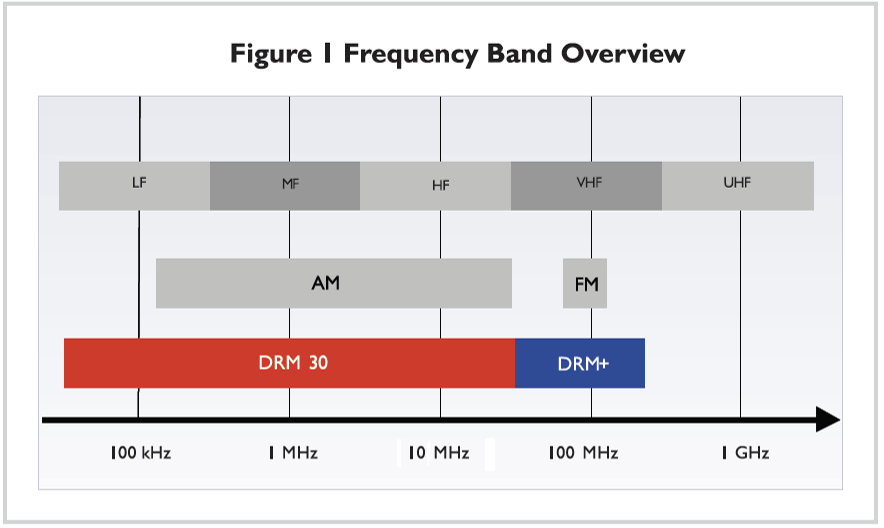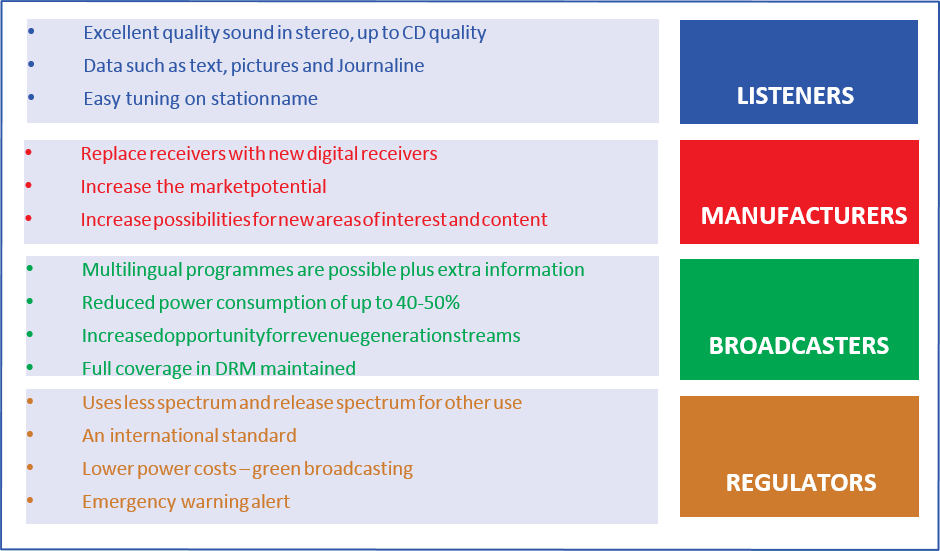WHAT IS DRM?
The DRM Broadcasting system has been designed by broadcasters, for broadcasters, with the active assistance and participation of both transmitter and receiver manufacturers and other interested parties (such as regulatory bodies). It has been designed specifically as a high-quality digital replacement for former analogue radio broadcasting in the AM and FM/VHF bands; as such it can be operated with the same channelling and spectrum allocations as currently employed. An overview of the frequency-bands where DRM operates is shown in Figure 1.

For the physical transmission, the DRM standard describes a number of different operating modes (i.e. modulation parameter sets), which may be broadly split into two groups as follows:
DRM transmissions below 30 MHz
4 different robustness modes allow the DRM signal to be tailored for the AM broadcast bands with their very diverse propagation characteristics, enabling regional up to international service coverage.
DRM transmissions above 30 MHz
A dedicated robustness mode is optimized for transmissions in the VHF bands, centered on the FM broadcast band, and used for local to regional service coverage.
Apart from these optimized robustness parameter sets and the resulting varying capacity for audio and data content, the Service Layer options and features of DRM as described below are identical for all operating modes, irrespective of the transmission frequency1.
DRM has received the necessary recommendations from the ITU, hence providing the international regulatory support for transmissions to take place. The main DRM standard has been published by ETSI. In addition, ETSI publishes and is the repository of the entire range of current DRM technical standards.
Apart from the ability to fit in with existing spectrum requirements, the DRM system also benefits from being an open standard2. All manufacturers and interested parties have free access to the complete technical specifications, and are able to design and manufacture equipment on an equitable basis. This has proved to be an important mechanism for ensuring the timely introduction of new systems to the market and for accelerating the rate at which equipment prices reduce. This is a significant consideration for broadcasters investing in DRM infrastructure, manufacturers investing in receiver development and production, and even more for the listeners who will need to invest in the new DRM-capable receivers.
[1] An open system or standard is one in which a complete system description is openly published with sufficient technical detail to allow a manufacturer to implement the whole or part of the broadcast chain.
[2] An open standard is one in which a complete system description is openly published with sufficient technical detail to allow a manufacturer to implement the whole or part of the broadcast chain.
WHY GO DIGITAL?
There is a global trend towards the adoption of digital technology in radio and communications, especially for distribution and transmission. Digitalisation offers many substantial advantages to national and international broadcasters and ‘infocasters’.
Implementation of digital radio in the AM and FM bands enables operators to provide services which will be successful with both existing and future high-quality services operating on other parts of the dial.
The introduction of DRM services allows a broadcaster to provide listeners with significant improvements in service reliability, audio quality and, most importantly, usability.
The DRM standard provides many features and facilities that are impossible to replicate in analogue broadcasting. It is essential that prospective broadcasters understand the potential and flexibility of the system in order to allow them to optimise and configure their DRM networks in accordance with their particular market conditions.
From a technical perspective, a key and revolutionary feature of DRM is the ability to select from a range of transmission capabilities. This allows the broadcasters to balance or exchange audio coding quality (bit-rate), error control (signal robustness), transmission power and coverage. What’s more, it is possible to do this dynamically, in response to any local changes in the environment, without disturbing the audience. A classic problem that can be mitigated by this feature is dealing with night-time sky-wave interference in the AM bands.
Furthermore, DRM is the only digital radio system that embraces all the currently used radio frequency bands; it provides an ideal replacement for existing analogue services as well as complementing other digital radio services based on open standards, such as DAB.
From a commercial perspective, there is no demand from audiences to ‘consume’ digital services for their own sake. It is essential therefore thatthe audience is presented with an attractive package of benefits:
• The availability of a wider range of services and more channels;
• Improved and more consistent sound quality;
• Programme-associated data, textual content description or even independent services such as traffic information.
• Easier tuning and selection of programming – e.g. automatic switching between different transmitters or electronic programme guides;
• Improved formats such as stereo in the ‘AM bands’ and surround-sound in cars;
The importance of quality content, while outside the scope of this guide, cannot be stressed too highly.
KEY SYSTEM FEATURES
The system is specifically designed to allow the new digital transmissions to co-exist with the current analogue broadcastsThe changeover from analogue to digital broadcasting can be phased over a period of time, which in turn allows broadcasters to spread the required investment to meet any budgetary constraints. Furthermore, unlike some other digital systems, the DRM system has been designed to allow suitable analogue transmitters to be modified to switch easily between digital and analogue broadcasts. This can significantly reduce the initial investment cost for a broadcaster. An additional financial benefit is the reduction of transmission energy costs.
For transmissions below 30 MHz, DRM exploits the unique propagation properties of the AM bands. The introduction of DRM services allows a broadcaster to provide listeners with more channels with significantly improved audio quality and service reliability. As a result, international broadcasters can provide services on HF (short wave) and MF (medium wave) that are comparable to local FM services, whilst enhancing the listener experience with easier tuning and added data services. National and local LF (long wave) and MF (medium wave) broadcasters will derive similar benefits.
For transmissions above 30 MHz, DRM can be configured to use less spectrum (half of the current analogue stereo FM broadcasts), whilst additionally deriving the potential benefits of increased robustness, more channels, reduced transmission power, increased coverage or additional services.
This is not all; a summary of the key benefits of DRM for the listeners, manufacturers, broadcasters and regulators is given in the table below

DRM also supports both multi- and single-frequency network operation, (MFN/SFN) and hand-over to other frequencies and even other networks (AFS – Automatic Frequency Checking & Switching). This latter feature allows a broadcaster operating on several different platforms to hand a listener from DRM to AM, FM or DAB and back again. The appropriate signalling is intrinsically supported by DRM and DAB, and by data carriers on analogue AM and FM (AMSS and RDS respectively).
Of particular note amongst the various data services are the SlideShow and Service and Programme Information (SPI), which allow listeners with appropriate receivers to access images and the broadcast schedule and set recording times accordingly, and Journaline, an interactive text application that provides convenient access to on-demand information as part of the free-to-air radio service.
DRM can alert the widest possible audiences in case of pending disasters through its built-in Emergency Warning Functionality (EWF), allowing it to serve as a last resort when all local infrastructure is down by covering the affected area with radio signals from outside. In case of an emergency, DRM receivers are ordered to switch to and present the emergency programme and may even be able to turn on automatically from standby mode. The emergency programme combines audio content, DRM text messages, and Journaline text with detailed look-up information in multiple languages in parallel. This emergency content may be accompanied by a visual alarm indicator and an automatic volume increase by the receiver.
DRM is being operated at power levels ranging from a few watts for local services on 26 MHz through to several hundred kilowatts on long-wave or even megawatts in the short or medium wave bands. It is possible to utilise the one technical standard to provide coverage ranging from international, national (ca. 1000 km), all the way down to local community radio (e.g. 1 km radius or less).
BACKGROUND: THE DRM CONSORTIUM
The DRM Consortium (Digital Radio Mondiale) is an international not-for-profit organisation composed of broadcasters, network providers, transmitter and receiver manufacturers, universities, broadcasting unions and research Institutes. Its aim is to support and spread a digital broadcasting system suitable for use in all the frequency bands up to and including VHF Band III. There are currently over 100 members and supporters from 39 countries active within the Consortium.
DRM was formed in Guangzhou, China in 1997, initially with the objective of “digitising” the AM broadcast bands up to 30MHz (long, medium and short-wave). The DRM System Specification for broadcasting below 30MHz (”DRM in AM”) was first published by ETSI in 2001.
Subsequently, a number of ancillary supporting standards were issued, including a Distribution and Communication Protocol. In 2005 a decision was taken to extend the DRM system to incorporate modes designed to operate in the VHF broadcasting bands. This required the addition of high-frequency modes, which, following refinement through laboratory testing and field-trials, resulted in the publication of the (extended) DRM specification ES 201 980 V4.1.1.

